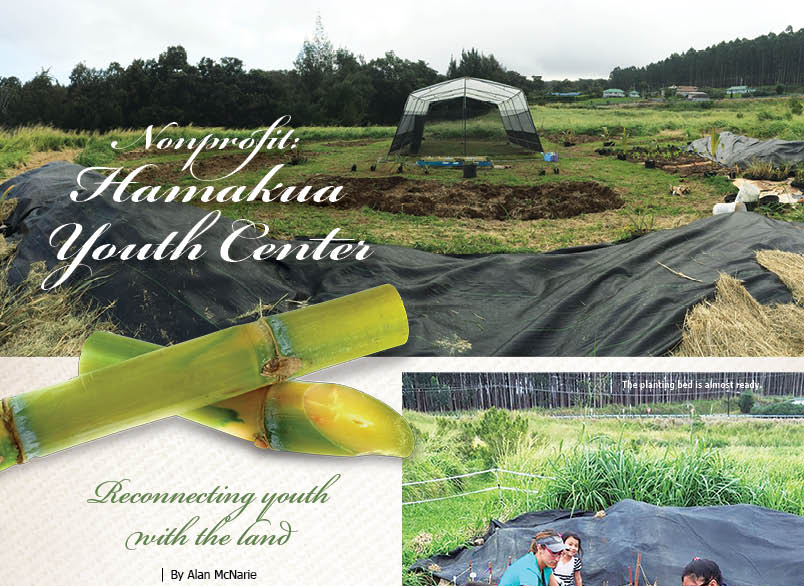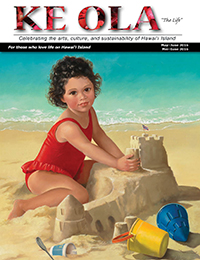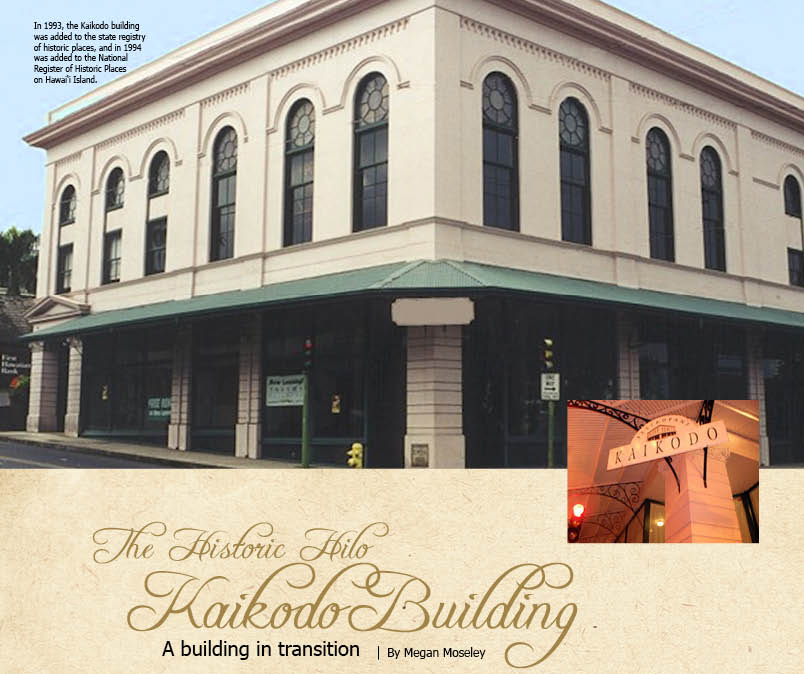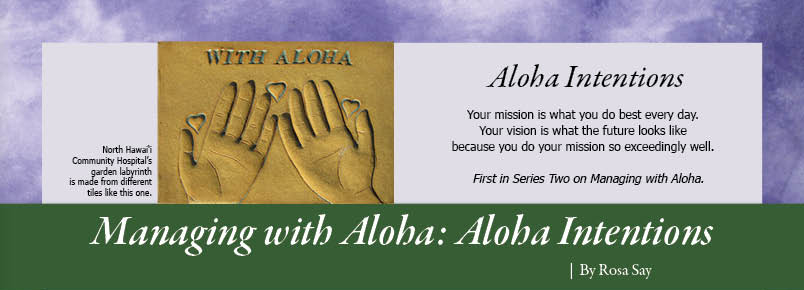
Hamakua Youth Center: Reconnecting Youth with the Land
By Alan D. McNarie
It’s a Wednesday afternoon in the former cane town of Honoka‘a on the Hāmākua Coast. Waves of hard, windy rain are pounding down. In the back of an elderly yet brightly painted former store building across from the Honoka‘a High School sports field, Mahealani Maiku‘i is helping some grade school kids with their homework, while her husband Karl chops vegetables and pounds ginger for soup. In the front room, a couple of local adults are playing guitar to entertain more kids.
“Aunty, what’s this word?“ asks one keiki (child), pointing to an unfamiliar collection of letters in his book.
“Truthfulness?” Mahealani responds. “That means honesty.”
Mahealani is the director of the only free after-school care program on the entire Hāmākua Coast. About 15-20 kids, from kindergarteners to high school seniors, show up on any given afternoon.
When the center was first founded as a YWCA program in 1991, she says, “Their main focus was to create a safe space for kids.”
It still does that, providing children with somewhere to go for a few hours between when school gets out and when their parents get home from work. Keiki at the center receive homework help, play games, socialize, and are fed.
As the organization has evolved, it’s broadened its goals to help kids with other needs: teaching them life skills, for instance, from cooking and sewing to cooperation and leadership. The center is working to help at-risk kids who need guidance and maybe some positive adult role models.
The Center has developed partnerships with other organizations, including the Hawai‘i County Prosecutor’s office, the Hāmākua public schools and local churches. It’s working with the schools and the prosecutor’s office, for instance, to develop programs that count for community service and even high school course credit. It’s partnering with the local Methodist Church on a program that teaches kids how to sew.
At the center itself, hungry kids not only get to eat; they get to help Karl and other volunteers prepare the food, while learning life skills from cooking to cleanliness.
“Even as little as this one is, they wash dishes,” says Mahealani, putting her arm around a six-year-old.
Learning those skills is a an especially urgent need in this scenic yet struggling district, which is still trying to recover from the closing of the sugar industry—moving from “the plantation era to the entrepreneurial era,” as Jack Zimmerman puts it.
Jack’s a member of the Hamakua Youth Council, the board of the 501c3 nonprofit that took over the operation of the center from the YWCA eight years ago. He stopped by today on other business; however, when he heard that a journalist was coming, he decided to stay and help field questions while Mahealani divides her time between the interview and the keiki. As she helps another student with a math problem, he explains another way the center has become more than just another place for kids to go.

“Just before Mahea came, we started expanding our program to studying Hawaiian culture through agriculture. It was through that program that she became connected with us,” he says. “We started developing our main themes: using Hawaiian culture as the lens to look at the multicultural community.”
The key here is “multicultural.” Hāmākua, like most of Hawai‘i, is ethnically diverse. In addition to the kanaka maoli (native Hawaiians) the people of Hāmākua represent at least four major cultural groups—European/American, Portuguese, Japanese, and Chinese. There is also a host of smaller yet still significant ethnicities: other Polynesian and Micronesian islanders; African Americans, Koreans, Latinos—not to mention the evolving island culture itself, with its own history and its own Pidgin language.
The plantations once brought most of those groups together, drawing them in from around the world with the offer of jobs and providing an economic and a psychological anchor for the community: a sense of security and a common enterprise. Then sugarcane left, taking at least 1,200 primary jobs with it, casting those groups adrift and leaving Hāmākua to reinvent itself.
For a while, the big companies that held the plantation lands tried, and failed, to sell the community on a scheme to sell eucalyptus trees for paper. Ironically, for a while the whole coast united around its opposition to the eucalyptus scheme, which would have tied up thousands of acres and created only 40 or so jobs, and had raised environmental concerns as well. It’s become clear, since then, that no single economic engine will replace sugar; the only solution is a host of smaller solutions.
If all those cultural groups no longer have sugar in common, what do they have?
One answer may be the land itself. Every single one of those cultures has its own tradition of agriculture, starting with the Hawaiians and kalo (taro), and Hāmākua still has plenty of land. One of the challenges the community faces is how to find ways to reconnect the coast’s youth with the land, before the kids drift away.
The Youth Center has launched itself into that challenge. It began sponsoring field trips to nearby Waipi‘o Valley, one of the last places where traditional Hawaiian wetland kalo farming has been continuously practiced for generations.
“What we did was to help—local style—local farmers in the field, and in turn they shared with them [the kids], talk-story style. Letting this make their own connecton to their own culture,” says Mahealani.
The kids got to meet, work, and talk story with four of Waipi‘o’s older taro farmers, she says. “One of the uncles said he was on one side of the valley watching the 1946 tsunami come in, and was on other side when the 1960 tsunami happened.” Such encounters, she believes, “just gave the kids a sense, just listening to the experiences of the kūpuna (elders)—it gave them a sense of grounding, no matter what.”
It affected the elders, as well.
“One of the older kupuna—when the kids started chanting, she started to cry. She started talking to them about when she first met her husband and what they used to do in Waipi‘o,” Mahealani recalls.
The humans weren’t the only kupuna that the children met: “We worked mostly with the four kūpuna, not just physically…in working with the huli [the living crown of the taro plant, which is replanted after the root is harvested]—the huli is also the ancestor, because you don’t know how far back they go.”
The center has also entered into a fruitful collaboration—literally—with a group called Hamakua Harvest, which shares its goal of reconnecting the people of the district with the soil—or, as its website summarizes, “to promote and advance Hāmākua agriculture by supporting local farmers, enriching the region’s social fabric, and promoting healthy rural lifestyles for the benefit of Hāmākua’s communities, economy, and environment.”
With the help of a joint Atherton grant, the two groups have started a half-acre garden on the outskirts of Honoka‘a, near the site of a farmers’ market that Hamakua Harvest also runs. In charge of both the market and the garden, from Hamakua Harvest’s end, is Julia Meurice, yet it’s been a collaborative effort between members of both organizations, as well as volunteers from the community.
Last January, volunteer Mark Mendes landscaped and laid out eight garden plots, and the center started bussing kids out for gardening classes. Three of those plots have been planted, so far, including a Hawaiian cultural heritage garden featuring “canoe plants” such as kō (sugarcane) and kalo. Beds of annual vegetables including swiss chard, tatsoi, broccoli, tomatoes, beets, okra, lettuce, dill, and kale are also in the ground. The center and its volunteers are contributing coconut palms, ti plants, a‘ali‘i (native hardwood trees) and avocado trees. “Fruit trees to come,” Julia adds.
When the garden is in full production, the two groups hope to sell the produce to local families and use the proceeds to sponsor agriculture-related scholarships and internships for the kids.
The Peace Committee of the Honoka‘a Hongwanji Mission, the local Buddhist temple, is another partner working with the center on an ambitious project: a series of afterschool “workshops” to teach local students about each of the area’s major cultural groups.
“We will include learning about culture, language, food [and cooking], as well as the contemporary pop culture (pop music, fashions, etc) in order to better reach teens and encourage harmony among all ethnic and demographic groups in our community,” explains the Peace Committee’s Miles Okumura.
Those plans acknowledge yet another culture: the common culture of kids themselves. There’s a reason why the workshops will focus on pop music, not classical music, says Jack Zimmerman. “The vision was to bring youth together from around Hawai‘i Island to be immersed in Hawaiian Culture and through that, they would create their own youth culture…that could recognize similarities in each of their communities—cyber-bullies, e-cigs, and so on—and also hopefully bring to life some sort of youth advisory council for our island.”
This isn’t the first time that the two groups have collaborated. They recently teamed up to bring magician Bruce Meyers to town for a youth-oriented show, and plan to invite him back to conduct a magic workshop.
“We have strategized working with the youth center because they are the most active, the go-to institution in town when it comes to working with children and students. They are singular as an agency in the Hāmākua area when it comes to trying to provide inspiration and moral education for youths,” believes Miles.
It’s all a lot of work, going each year after a dwindling pool of grant money and then eking it out with the sweat equity of volunteers. However, some of the rewards are beyond money. Mahealani recalls teaching a lesson on the Hawaiian phases of the moon “as my parents taught me,” then having one of those moments beyond price, when a young girl took over the lesson.
“To see your little first grader be the leader for the rest of the group, and watching that they had respect for her in that way and not to intimidate her.…She had the confidence to stand there in front of her older peers and recite the moon phase chant back and recite it to them, and they had the respect to recite it back [to her]. To me that measures success, when we can have our 7-year-old stand there and be confident enough to lead the group.” ❖
Photos courtesy of Hamakua Youth Center
Contact Hamakua Youth Center: 808.775.0976, Email
Contact writer Alan D. McNarie



